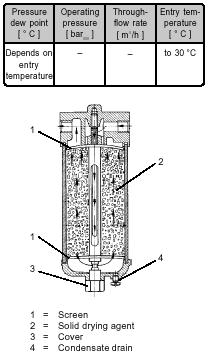<BR> Fig. 5.10: Absorption dryer with solid drying agent
Fig. 5.10: Absorption dryer with solid drying agent | With absorption drying the moisture is separated by a chemical reaction with a hygroscopic drying agent. Since the absorption properties of the drying agent diminish over time, periodic renewal is necessary.
There are 3 different types of drying agent. The soluble agents liquify with increased absorption. The solid and liquid agents react with the moisture without changing their aggregate status.
<BR><BR> |